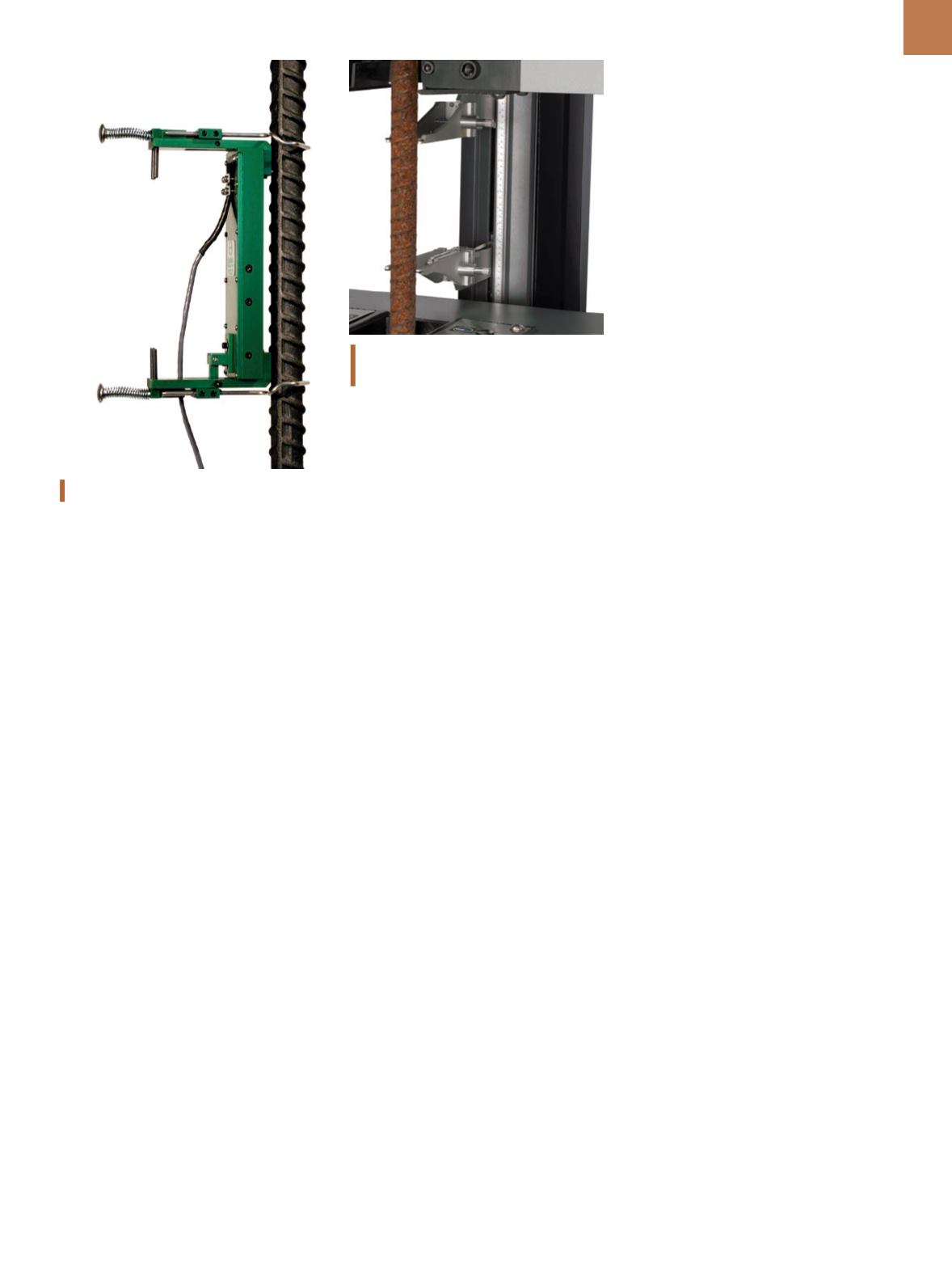

A D V A N C E D
M A T E R I A L S
&
P R O C E S S E S | J U N E
2 0 1 5
2 5
If a distinct
yield point
(upper yield
strength—ReH) is visible, yield strength
can be determined without an exten-
someter by reporting the stress value
at this point.
Elongation after fracture
(ASTM and ISO) and
total elongation at
maximum force
(ISO) can both be de-
termined manually after the test from
marks placed on the specimen surface.
However, there are many times
when an extensometer must be used
in order to calculate results such as
off-
set yield
(Rp 0.2) or when determining
elongation values automatically from
an extensometer instead of manually
from specimen marks. In these cas-
es, extensometers typically have large
gauge lengths compared to those used
on machined metal specimens. They
must also be robust enough to with-
stand scale falling on them during test-
ing and be able to attach to the uneven
surface of deformed bars. Depending
on the deformations, they can be at-
tached to the flat surfaces in between
deformations or on a longitudinal rib if
one exists.
The most common extensometers
used in rebar testing are manual clip-on
style instruments attached directly to
the rebar prior to running the test. If the
instrument is not designed to remain
“on” through failure, it must be man-
ually removed after yielding occurs,
but before the specimen fails. Manu-
al instruments designed to withstand
specimen failure offer advantages, but
will likely experience faster wear of the
knife edges if frequently used through
failure.
Most manual instruments are also
designed with a fixed gauge length.
However, when testing many sizes of
rebar with varying gauge lengths, it is
necessary to have several extensome-
ters that have different lengths. Some
manual instruments are available that
can be configured for several differ-
ent gauge lengths, allowing a single
instrument to cover most common re-
quirements. Such devices require the
operator to manually configure the in-
strument properly between tests that
require a different gauge length.
Automatic
contacting
instru-
ments offer several advantages over
manual devices. Automatic removal
and attachment allow the operator to
stay out of the test space, eliminat-
ing risks associated with specimen
failures. The gauge length is set auto-
matically from software inputs and is
infinitely adjustable over the entire
travel of the instrument, allowing a
single instrument to cover all speci-
men requirements. It can also be left
on through failure if desired. Auto-
matic instruments are likely the best
solution if automatic recording of
elongation measurements is required.
TESTING SPEEDS
AND CONTROL
One challenging aspect of comply-
ing with test standards is determining
how to properly and efficiently execute
the tensile test. Despite standards pro-
viding specific details for allowable test
speeds and control modes for differ-
ent stages of the test, performing tests
properly can still be difficult. This may
be due to both standard interpretation
challenges and test equipment limita-
tions. Details that influence test con-
trol and speeds can be found scattered
throughout various sections of test
standards. Referencing more than one
standard might be necessary in order
to have all the required test setup infor-
mation. This can make it very difficult
to fully understand all aspects of the
test sequence and how to make it work
on a given testing system.
For rebar tensile testing, breaking
the test into separate stages is helpful.
This applies regardless of which test
standard is being followed. The five ba-
sic regions include:
•
Pretest
•
Preload
•
Elastic region
•
Yielding
•
Plastic region
Pretest:
During the pretest stage,
the machine is prepared for testing.
The proper grips are installed and test
opening adjustments are made. Prior
to installing the specimen, the force
(load) measurement should be set to
zero. Once the specimen is loaded into
the system, the force should not under-
go any further “zeroing” as this will af-
fect the test results. If using a manual
extensometer for measuring strain, it
should be attached to the specimen
while making sure to properly set the
knife edges at the instrument’s gauge
length. Strain measurement should
then be set to zero prior to loading the
specimen.
Preloading:
The preloading stage
is used to apply a minimal preload
AutoX750 testing #11 (36 mm) rebar on an
Instron 1500 KPX.
Manual, clip-on style rebar extensometer.


















